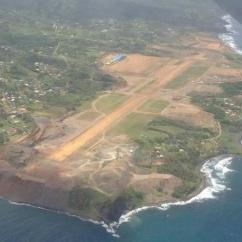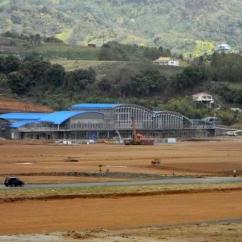
St. Vincent and the Grenadines knew it had an access problem for many years. Fortunately, that problem is in the midst of being solved thanks to International Airport Development Company (IADC) Ltd. and the development of Argyle International Airport.
“There has always been a desire to build a new airport here, and past efforts to solve capacity problems through solutions at other island hubs weren’t satisfactory,” CEO Dr. Rudolph Matthias says. “The airport will eliminate delays involved with waiting for connecting flights and transferring from large to small planes, as people will be able to fly in and out directly.”
Because the country has been shifting its economy toward a greater reliance on tourism, a satisfactory solution was necessary. The island nation traditionally has relied on the agricultural sector, particularly banana production. However, the cost of producing bananas in St. Vincent and the Grenadines is high relative to Latin American competitors.
“We have a good tourism product, but it is underdeveloped,” Matthias says. “We see the airport as an engine of economic growth.”
IADC is a wholly owned government limited-liability corporation that primarily exists to manage and oversee the completion of the airport project, as well as to secure its financing and construction. After decades of searching for a solution to improve air access to the island nation, IADC was incorporated on Nov. 24, 2004.
Overcoming the Odds
Ever since then, the company has been working to turn the Argyle International Airport dream into reality. One of the first decisions that needed to be made was where to put the new airport. The site of a smaller airport – E.T. Joshua Airport in the city of Arnos Vale – wasn’t workable because of various technical, economic and natural obstacles.
Eventually, the Argyle site was chosen. The Argyle International Airport will be situated on 275 acres of land. It will include a paved runway that will be 9,000 feet long and 147 feet wide, able to accommodate jets as large as the Boeing 747-400s. The airport’s terminal will occupy more than 150,000 square feet and will have a capacity to handle around 1.4 million passengers annually.
The entire cost of the project is approximately $250 million. The island has a population of 110,000 people and a GDP of about $1.5 billion. Clearly, this is a massive project relative to the size of the nation’s economy. Borrowing the entire cost of the project would have saddled the island with massive debt and prevented it from making other investments. Fortunately, the government of St. Vincent and the Grenadines has been able to secure resources in cash and kind from Cuba, Venezuela, Taiwan, Trinidad and Tobago, Mexico, Austria, Iran, Libya, Georgia and Caricom Development Fund.
“For example, we received a loan and grant of $30 million from Taiwan used for the design of the terminal building and other landside facilities and the construction of some of these facilities,” Matthias says. “The designs were done by the Taiwanese firm CECI Engineering Consultants, and the construction of the terminal building is contracted to another Taiwanese firm, Overseas Engineering and Construction Company. Cuba provided technical support, and along with Venezuela, helped with preliminary studies and airside designs. Venezuela also provided equipment such as excavators, bulldozers, graders and scrapers.”
On The Right Track
Shovels hit the ground in August 2008 and the project construction should be done December 2013. Once that work is complete, the project can move on to equipment testing in the first quarter of 2014, ahead of full operation by most likely by the second quarter of 2014.
“Right now, we are in the process of getting ready for pavement work on the apron, taxiways and the runway,” Matthias says. “We received a grant and loan of almost $4.2 million from the Caricom Development Fund to help with the purchase of a stone-crushing plant and other equipment to prepare for the paving works.”
The earthwork has been a complex process. The site had various mountains and valleys that needed to be flattened and filled, respectively. There is a river that runs through the airport runway, and a segment of a highway needed to be diverted. Almost 40 percent of the cost of the project has gone toward earthworks. The site also has been found to be home to many historical artifacts from native Carib and colonial times.
“It is a rich archeological site, and although we are building for the future, we are helping to uncover evidence of our past,” Matthias says.
For more than two years, the nation’s Tourism Authority has been working with Boyd Group International of Colorado to market the airport. They have been meeting with carriers to gauge interest in adding Argyle International Airport to their schedules.
The nation has thousands of visitors every year from the United States, Canada and the United Kingdom, as well as thousands more from Europe, South America and other island nations. It is likely that many airlines will be looking forward to staking a claim at the airport.
For now, the project is working through many more aspects before its ultimate completion. Pavement works; the installation of lights and navigational aides; and construction of a fire station, cargo terminal and control tower all remain on the to-do list. Although the major aspects of the project – remaining earthwork, terminal construction and runway/taxiway paving – are funded, IADC is still hard at work securing funds to ensure that all aspects of the project wrap up by the end of 2013. Success is a must, as this project is critical to the future of an island nation that has much to offer the rest of the world.
Article by Eric Slack Construction Today
- Login to post comments



Recent comments
9 years 12 weeks ago
9 years 32 weeks ago
9 years 36 weeks ago
9 years 40 weeks ago
9 years 41 weeks ago
12 years 7 weeks ago
12 years 21 weeks ago
12 years 41 weeks ago